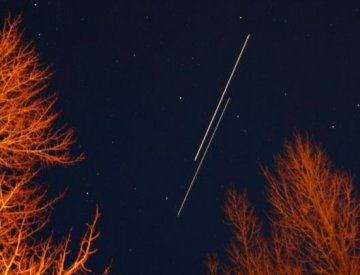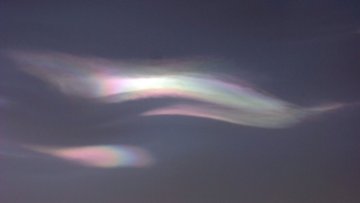 Would you like a call when auroras appear over your hometown? Sign up for Spaceweather PHONE.
Would you like a call when auroras appear over your hometown? Sign up for Spaceweather PHONE.
SOLAR WIND: Sky watchers in Scandinavia and Alaska should be alert for auroras. A high speed solar wind stream is buffeting Earth's magnetic field, and this could cause a mild geomagnetic storm. BONUS: The view from space.
DOUBLE FLYBY: The space shuttle Discovery undocked from the International Space Station last night, Dec. 19th, at 5:09 pm EST. About two and a half hours later the pair flew in tandem over Laramie, Wyoming, where Jeff Greenwald took this picture:

Photo details: Canon 20D, 400 ISO, 15s exposure,
"The picture does not do it justice," says Greenwald. "As my 10 year old son said, That was so cool! Both spacecraft were very bright, and they appeared to drift further apart as they flew over our heads."
more images: from Carol Lakomiak of Tomahawk Wisconsin; from Kel Krosschell of Rochester, Minnesota; from Jim Donovan of Placerville, California; from Jeffrey J. Berkes of West Chester, Pennsylvania.
POLAR CLOUDS: "If you live in or near the Arctic, now is the time to look for nacreous clouds," says atmospheric optics expert Les Cowley. Just yesterday Patricia Cowern of Porjus, Sweden, photographed these floating 40 miles north of the Arctic Circle:

Photo details: Canon 10D, 100 asa, 1/60th sec.
"These rare clouds, also called Type II Polar Stratospheric Clouds or PSCs, ride 9 to 16 miles up in the stratosphere, far above everyday clouds," explains Cowley. "They need extraordinarily low temperatures, minus 85 C (-120 F), which is why Arctic winter is the best time to see them. Check the skies before dawn or up to two hours after sunset. They are an unforgettable sight as they glow like an electric discharge, silently and slowly curling and stretching in the frigid stratospheric winds."
"These are the first ones I have seen this winter," notes Cowern. "They were small but pretty. Now I wait in anticipation for larger displays."
December 2006 Aurora Gallery
updated: Dec. 20th

